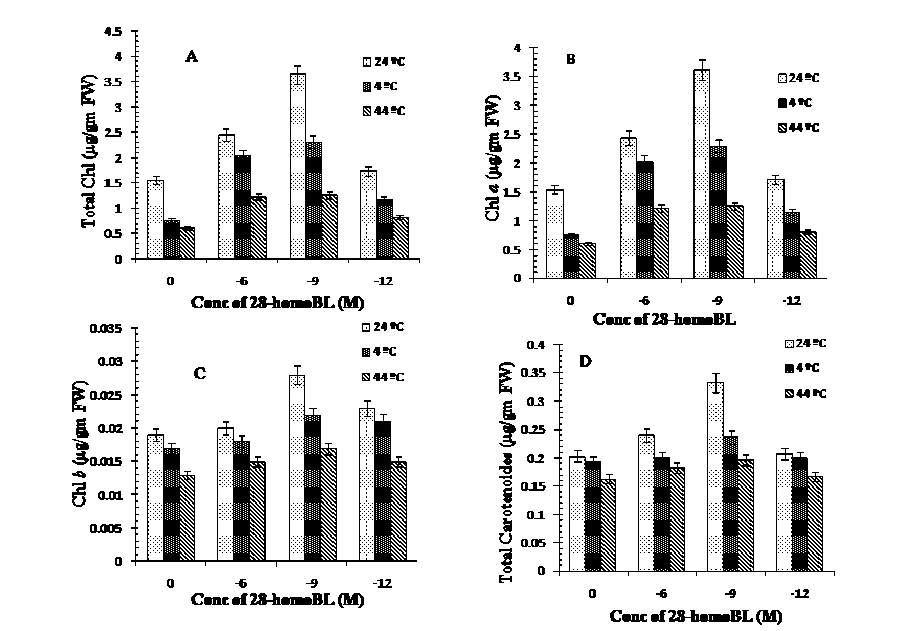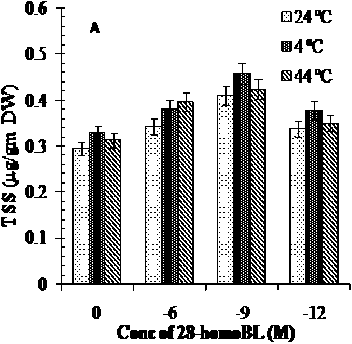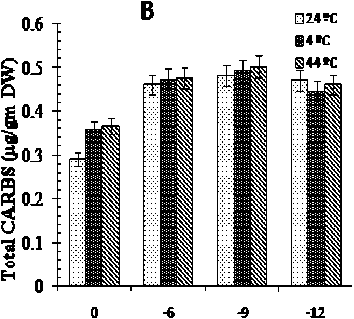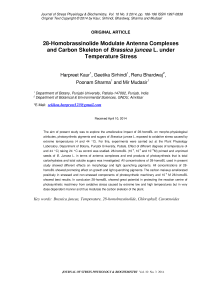28-homobrassinolide modulate antenna complexes and carbon skeleton of Brassica juncea L. under temperature stress
Автор: Kaur Harpreet, Sirhindi Geetika, Bhardwaj Renu, Sharma Poonam, Mudasir Mir
Журнал: Журнал стресс-физиологии и биохимии @jspb
Статья в выпуске: 3 т.10, 2014 года.
Бесплатный доступ
The aim of present study was to explore the ameliorative impact of 28-homoBL on morpho-physiological attributes, photosynthetic pigments and sugars of Brassica juncea L. exposed to oxidative stress caused by extreme temperatures (4 and 44 °C). For this, experiments were carried out at the Plant Physiology Laboratory, Department of Botany, Punjabi University, Patiala. Effect of different degrees of temperature (4 and 44 °C) taking 24 °C as control was studied. 28-homoBL (10 -6, 10 -9 and 10 -12M) primed and unprimed seeds of B. Juncea L. in terms of antenna complexes and end products of photosynthesis that is total carbohydrates and total soluble sugars was investigated. All concentrations of 28-homoBL used in present study showed different effects on morphology and light quenching pigments. All concentrations of 28-homoBL showed promoting effect on growth and light quenching pigments. The carbon makeup ameliorated positively in stressed and non-stressed components of photosynthetic machinery and 10 -9 M 28-homoBL showed best results. In conclusion 28-homoBL showed great potential in protecting the reaction centre of photosynthetic machinery from oxidative stress caused by extreme low and high temperatures but in very dose dependent manner and thus modulate the carbon skeleton of the plant.
Brassica juncea, temperature, 28-homobrassinolide, chlorophyll, carotenoides
Короткий адрес: https://sciup.org/14323887
IDR: 14323887
Текст научной статьи 28-homobrassinolide modulate antenna complexes and carbon skeleton of Brassica juncea L. under temperature stress
Temperature is one of the most important environmental stresses that adversely affect plant growth and development thereby limiting plant productivity. It causes heat injury and chilling stress, which results into degradation and collapsing of proteins, lipids and bring changes in metabolism. These changes cause break down of cell products and membranes etc. Temperature stress accelerates generation of reactive oxygen species (ROS) that have the capacity to initiate lipid peroxidation and degrade proteins, lipids and nucleic acids (Halliwell and Gutteridge, 1999). Plants respond to temperature stress by changes in the levels of antioxidants and antioxidative enzymes (Noctor and Foyer, 1998; Pandey et al., 2005). Several hormones are implicated in modulating the plant responses to oxidative stress, including ethylene (Vahala et al., 2003), abscisic acid (Kovtun et al., 2000), salicylic acid (SA) (Metwally et al., 2003) and brassinosteroids (BRs) (Cao et al., 2005).
Brassinosteroids are a class of plant polyhydroxysteroids that are ubiquitously distributed in the plant kingdom. These compounds, when applied to plants, improve their quality and yield. They have been further explored for stress-protective properties in plants against a number of stresses like chilling (Dhaubhadel et al ., 1999), salt (Ozdemir et al ., 2004), heat (Dhaubhadel et al ., 2002) and heavy metals (Bajguz, 2000; Janeczko et al ., 2005). The studies conducted with brassinosteroid biosynthetic mutants of pea ( Pisum sativum ) (Nomura et al ., 1997), tomato ( Solanum lycopersicum ) (Koka et al ., 2000), and fava bean ( Vicia faba ) (Fukuta et al ., 2002) provided compelling evidence for the vital role of this group of growth regulators for normal growth and development. Inhibition studies employing brassinozole, a specific inhibitor of brassinolide synthesis in plants, further fortified the view that brassinosteroids are indispensable for plant growth and development (Asami et al ., 2000). The ability of brassinosteroids to improve the performance of cereals, vegetable crops, oil seed plants, and fruit crops has been widely reported (Ramaj et al ., 1997; Khripach et al ., 1999;
Vardhini et al ., 2006). However, it is unclear whether BRs are involved in the modulation of plant photosysthetic machinery under oxidative stresses.
Brassica juncea L. is an important oilseed crop known for its oil content, edible and medicinal uses. The seed is a warming stimulant with antibiotic effects. The chemical constituents of B. juncea include glucosinolates, ascorbate, foliate, myrosinase, sterols (brassicasterol, sitosterol and brassinosteroids).The present study was undertaken to observe the growth, contents of photosynthetic pigments, carbohydrates and sugars under the influence of 28-homobrassinolide (28-homoBR).
MATERIALS AND METHODS
Seeds of B. juncea L. cultivar. (RLC-1) were procured from the Department of Plant Breeding, Punjab Agriculture University, Ludhiana, India. This is an improved variety of Brassica launched for farmers of Punjab. This is resistant certified variety having more seed production as compare to other varieties. Seeds were surface sterilized with 0.01% HgCl2 and rinsed 5-6 times with double distilled water. The sterilized seeds were soaked for 8h in different concentrations of 28-homoBL (Sigma-Aldrich. USA) (0, 10-6, 10-9 and 10-12M). The treated seeds were propagated in triplicate in Petri dishes under lab conditions at 20 ± 2°C and 16-h photoperiod while 7-days old seedling were exposed to 44°C and 4°C for 5h daily for three days. After 44°C and 4°C temperature shock treatment, seedlings were transferred to normal lab conditions. Plants were sampled on the 10th day after sowing for measuring morphological parameters (root length and shoot length), photosynthetic pigments, total soluble sugars and total carbohydrates.
The root and shoot length of B. juncea L. seedlings were taken on 10th day after sowing. Fresh weight of seedlings also taken on 10th day of sowing, 25 seedlings of Brassica juncea seedlings were taken for cunning fresh weights. Then seedlings were placed into oven at 100°C for 24 hrs and dry weights of seedlings were taken.
Biochemical parameters
Photosynthetic pigments
The Chl a, Chl b, total Chlorophyll and Carotenoids were extracted according to Arnon method (1949). Brassica seedlings (0.5g) were ground using mortar and pestle in 5ml of 80% acetone, then the developed colour was measured at 470, 645, and 663nm. The amount of pigments was calculated according to Lichtenthaler et al ., (1982).
Total Soluble Sugars
Total sugars content was estimated by following Loewus, (1952). Known weight of dried plant material was homogenised in 80% of ethanol then centrifuged at 3000x g for 15 minutes and the extract was collected for sugars estimation. For total sugars 0.05ml of extract was diluted to 2ml by distilled water and adds 3ml cold anthrone reagent was added into it and mixed thoroughly. Then mixture was heated for 10 min in boiling water bath and cooled rapidly at room temperature. O.D. was recorded at 630 nm. Amount of total sugars was calculated and expressed as mg/g DW tissue.
Total Carbohydrates
Total carbohydrates content was determined according to Dubois et al ., (1956). 0.05ml of extract was diluted to 2ml by distilled water and 0.05 ml of phenol reagent was added to it and mixed thoroughly. Then 5ml of H 2 SO 4 was added rapidly. Blank was prepared by taking distilled water instead of extract. The samples were allowed to stand at room temperature for 30 minutes and optical density was taken at 485 nm. Standard curve was prepared by using glucose (20-100 mg). The amount of carbohydrates was calculated and expressed as mg/g dry weight.
The data obtained was statistically analyzed using one-way ANOVA (Bailey, 1995). Data were presented as means ± SE.
RESULTS
Morphological parameters
28-homoBL treated seeds resulted in increased percent shoot length (Table 1) of Brassica juncea as compared to control. Maximum (39%) increase in shoot length was observed in seedlings treated with 10-9M 28-homoBL concentrations. Seedlings grown in presence of 4 °C and 44 °C showed (13 % and 27 %) decrease respectively. Interestingly seeds grown in presence of 4°C temperature after treatment with 10-9M concentrations of 28-homoBL showed (16%) increase in shoot length rate as compared to control distilled water seeds.
Seedling growth in terms of root length showed synergistic mechanism of negative effect on growth particularly on root length. Root length affected negatively in all concentrations of 28-homoBL except 10-9 M where (1%) increase was found. Overall 28- homoBL showed stimulatory effect on shoot length temperature as compared to control (Figure 1A). It and inhibitory effect on root length in presence or was (52% and 61%) lower as compared to control in 4
absence of temperature.
°C and 44 °C respectively. Applications of different
In case of fresh and dry weights (Table 1) maximum decrease was found in seedlings treated with 44 °C temperature (14%) and (18%) respectively but when supplementation of different concentrations of 28-homoBL is given maximum increase (25 %) fresh weight and (14%) dry weight was found in seedlings treated with 4 °C temperature stress.
concentrations of 28-homoBL under temperature stress enhance Chlorophyll content to significant high level. Maximum total chlorophyll content was observed in case of seedlings treated with 4 °C supplemented with 10-9 M 28-homoBL which was (48%) high as compared to control. Similarly, in case of Chl a and Chl b (Figure B and C) temperature showed its negative effect. Maximum decrease in Chl a (61 %) and Chl b (32%) was found in 44 °C
The significant effect of 28-homoBL treatment was temperature but when supplementation of different observed on the biochemical parameters in Brassica concentrations of 28-homoBL was given (48 %) and juncea seedlings. Total chlorophyll content (Figure 1)
(15%) increase was found in Chl a and Chl b was decreased with increased degrees of respectively.

Figure 1. Effect of 28-homoBL on Total Chlorophyll (A), Chlorophyll a (B), Chlorophyll b (C),
Carotenoides content (D) on 10-days old seedlings of B. juncea L. plants under temperature stress [Bars represent the SE (n=3)]

Figure 2. Effect of 28-homoBL on Total soluble Sugars content (A), Total carbohydrates (B), on 10-days old seedlings of B. juncea L. plants under temperature stress [Bars represent the SE (n=3)]

Cent ef 2S heneeBL (M)
Table. 1: Influence of pretreatment of 28-homoBL on shoot, root length and fresh, dry weights under temperature stress.
|
Treatment |
Shoot Length(cm) |
Root Length(cm) |
Fresh Weight(mg) |
Dry Weight(mg) |
|
Control |
3.99 ±0.02* |
4.7±0.04* |
1128±0.05* |
52±0.04* |
|
10-6M 28-homoBL |
4.55 ±0.01* |
4.59±0.09 |
1439±0.06 |
61.6±0.01* |
|
10-9M 28-homoBL |
5.55 ±0.04* |
4.76±0.02* |
1456±0.05* |
63.6±0.03* |
|
10-12M 28-homoBL |
5.16 ±0.06 |
4.41±0.01* |
1424±0.02* |
55.3±0.06 |
|
4 °C |
3.49 ±0.06 |
4.1±0.07 |
1062±0.02* |
48.6±0.05* |
|
44 °C |
2.93 ±0.03* |
2.83±0.05* |
971±0.04* |
43±0.02* |
|
10-6M+4°C |
3.82 ±0.02* |
4.33±0.08 |
1266±0.02* |
54.3±0.02* |
|
10-6M+44°C |
3.6 ±0.05* |
3.22±0.06 |
1164±0.04* |
47.3±0.06 |
|
10-9M+4°C |
4.66 ±0.07 |
4.38±0.03* |
1414±0.03* |
59.3±0.02* |
|
10-9M+44°C |
3.94 ±0.04* |
4.33±0.02* |
1202±0.07 |
53±0.01* |
|
10-12M+4°C |
3.6 ±0.01* |
4.38±0.05* |
1336±0.09 |
53.6±0.01* |
|
10-12M+44°C |
3.18 ±0.03* |
3.05±0.05* |
1119±0.02* |
46.6±0.04* |
Values are the mean of three replicates measurements
* Indicate significant difference compared to the control at p < 0.05
A similar trend was observed when effect of 28- carotenoids under temperature stress (Figure 1D).
homoBL was studied on the contents of total Carotenoids content (Figure 2A) was (20%) lowest in
44 °C and (5%) lowest in 4 °C as compared to control. Carotenoid content was (16%) more in seedlings treated with 10-9 M homoBL supplemented with 4 °C temperature.
Total sugars content was increased with increased temperature stress (Figure 2A). Seedlings treated with 44 °C showed (11%) increase in total sugars content as compared to control. Seedlings treated with 28-homoBL alone showed significant increase in total sugars content (Figure 2A) in comparison to untreated seedlings. The total sugars content was significantly higher in the seedlings treated with temperature shocks supplemented with 28-homoBL than temperature alone.
Interestingly, maximum increase in total carbohydrates (Figure 2B) (73%) increase was observed in seedlings treated with 10-9 M 28-homoBL under 44 °C as compared to temperature-treated seedlings only, where (26 % and 23%) increase were found in 44 °C and 4 °C respectively.
DISCUSSION
Preliminary studies have demonstrated that homoBL improved chilling tolerance in Cucumis sativus (Fariduddin et al. 2011) and also under various stresses viz. moisture stress in wheat (Sairam 1994), thermo tolerance of brome grass (Wilen et al. 1995), cold treated rape leaves (Janeczko et al. 2007), and various heavy-metal stresses (Ali et al. 2008, Hasan et al. 2008, Fariduddin et al. 2009a). EBR treatment improved heat tolerance of wheat leaf cells (Kulaeva et al. 1991), and brome grass suspension cells (Wilen et al. 1995). In the present study, B. juncea seedlings showed susceptibility to temperature stress. After temperature stress treatment to seedlings, growth (e.g., shoot and root length) was significantly inhibited. Temperature stress decreased shoot length of tomato seedlings as reported by Singh and Shono (2005) and in barley and radish seeds by Cavusoglu and Kabar (2007). Our previous studies also illustrated that BR protects plants starting from their germination till maturity by up and down regulation of various non-enzymatic and enzymatic activities at the cellular level (Sirhindi et al. 2009). BRs also enhanced the plant growth after direct sowing in submerged paddy pots at low temperature (Bajguz and H ayat 20 0 8).
In case of photosynthetic pigments, The present results showed that the contents of photosynthetic pigments (Total chl, chl a, chl b and carotenoids) were significantly reduced with increasing temperature stress (Figure. 1) in B. juncea L. plants compared with those of non-salt-stressed plants. These results are consistent with those of Sharma et al. (2012), who found that, at temperature stress regimes, a slight decrease was noted in chlorophyll and carotenoid contents, but under high-temperature conditions a significant reduction in the content of these pigments was observed in case of A. oryzae and A. ellipsospora. This decrease in photosynthetic pigments is consistent with the suggestion that, photosynthesis is the first most vulnerable physiological process inhibited by temperature stress (Berry and Bjorkman, 1980). Temperature directly effect the functioning of photosynthetic apparatus, essentially by disrupting all major components of photosynthesis, including the thylakoid electron transport, the carbon reduction cycle and the stomatal control of CO2 supply (Allen and Ort, 2001). In addition, temperature stress has been ascribed to induce changes in the ultrastructure of chloroplast (Kratsch and Wise, 2000) and the chloroplast may lose its capacity to capture light energy after a long chilling period (Yang et al., 2005). Kagale et al. (2007) reported that BRs treatment enhanced tolerance to drought and cold stress in Arabidopsis thaliana and Brassica napus seedlings. In present study 28-homoBL might be the possible reason for improved photosynthetic pigment contents by modulating production of ROS in electron transport channels.
The carbohydrate fractions (soluble sugars, insoluble sugars and total carbohydrates) and total sugar contents of leaves were markedly increased (Figure 2) in temperature-stressed B. juncea plants. Such carbohydrate and sugar accumulation was recorded by other authors (Liu and Huang. 2000 Gent. 1986; Charles et al., 1992; Rosa et al., 2009). The increase in carbohydrate and photosynthetic pigment contents were directly proportional to the applied temperature stress and 28-homoBL concentrations. These results led to the conclusion that temperature stress may regulate the accumulation of sucrose that is a storage carbohydrate and can be rapidly mobilized as metabolic needs require, and at temperature stress, its accumulation is simply for that reason. In this role, sucrose could be rapidly loaded into the translocation stream or quickly used for respiratory energy and anaplerotic metabolite production upon return to more favorable temperatures. One would expect little debate regarding such a contention. The fact that oligosaccharide metabolism seems to depend on sucrose accumulation would also support a role in storage (Pollock. 1987). In addition, the Brassinosteroides can regulate cellulose biosynthesis, by controlling expression of CESA genes (Liqiong et al., 2011) that are considered to be the principle regulator in increasing carbohydrate and sugar accumulation subjected to temperature conditions, highlight another possible mechanism by which 28-homoBL plays a positive role in alleviation of the harmful effects of temperature stress.
CONCLUSION
The present study shows that, although temperature is essential for normal plant growth and physiological processes, above threshold value temperature is toxic and may result in growth inhibition and altered metabolic processes. The observations of the present study clearly indicate temperature stress-protective properties of 28-homoBL in Brassica juncea plants. Stress ameliorative properties of 28-homoBL are clearly demonstrated by better growth, increased photosynthetic pigment contents, total sugars and total carbohydrates in seedlings to which various degrees of temperature and 28-homobrassinolides were applied. It points to the possibility of BR-regulated stress-protection in plants but extensive studies are still needed on various aspects related to stress.
ACKNOWLEDGEMENTS
Список литературы 28-homobrassinolide modulate antenna complexes and carbon skeleton of Brassica juncea L. under temperature stress
- Ali, B., Hayat, S., Hasan, S. A., Hayat, Q., Yadav, S., Fariduddin, Q., Ahmad, A. (2008) A role for brassinosteroids in the amelioration of aluminium stress through antioxidant system in mung bean (Vigna radita L. Wilczek). Environ Exp Bot., 62, 153-159
- Allen, D. J., Ort, D. R. (2001) Impact of chilling temperatures on photosynthesis in warm climate plants. Trends Plant Sci., 6, 36-42
- Arnon, D. I. (1949) Copper enzymes in isolated chloroplasts, polyphenoxidase in Beta vulgaris. Plant Physiol., 24, 1-15
- Asami, T., Min, Y. K., Nagata, N., Yamagishi, K., Takatsuto, S., Fujioka, S., Murofushi, N., Yamaguchi, T., Yoshida, S. (2000) Characterization of Brassinozole, a Triazole-Type Brassinosteroid Biosynthesis Inhibitor. Plant Physiol., 123, 93-100
- Bailey, N.T. J (1995) Statistical Methods in Biology. The English University Press, London
- Bajguz, A. (2000) Blockage of heavy metal accumulation in Chlorella vulgaris cells by 24-epibrassinolide. Plant Physiol Biochem., 38, 797-801
- Bajguz, A., Hayat, S. (2009) Effects of brassinosteroids on the plant responses to environmental stresses. Plant Physiol Biochem., 47, 1-8
- Berry, J., Björkman, O. (1980) Photosynthetic response and adaptation to temperature in higher plants. Annu. Rev Plant Physiol., 31, 491-543
- Cao, S., Xu, Q., Cao, Y., QiAn, K., An, K., Zhu, Y., Binzeng, H., Zhao, H., Kuai, B. (2005) Loss of function mutation in DET2 gene lead to an enhanced resistance to oxidative stress in Arabidopsis. Physiol Plant., 123, 57-66
- Charles, L. Guy, Joan, L. A., Huber and Steven, C., Huber. (1992) Sucrose Phosphate Synthase and Sucrose Accumulation at Low Temperature. Plant Physiol., 100, 502-508
- Dhaubhadel, S., Browning, K. S., Gallie, D. R., Krishna, P. (2002) Brassinosteroid functions to protect the translational machinery and heat-shock protein synthesis following thermal stress. Plant J., 29,681-691
- Dhaubhadel, S., Chaudhary, S., Dobinson, K. F., Krishna, P. (1999) Treatment with 24-epibrassinolide (brassinosteroid) increases the basic thermotolerance of Brassica napus tomato seedlings. Plant Mol Biol., 40, 333-342
- Dubois, M., Gilles, K. A., Gilles, J. K., Hamilton, P. A., Rebers, F. Smith (1956). Colorimetric method for determination of sugars and related substances. Anal Chem., 28, 350-356
- Fariduddin, Q., Yusuf, M., Chalkoo, S., Hayat, S and Ahmad, A. (2011). 28-Homobrassinolide improves growth and photosynthesis in Cucumis sativus L. through an enhanced antioxidant system in presence of chilling stress. Photosynthetica., 49(1), 55-64
- Fariduddin, Q., Khanam, S., Hasan, S. A., Ali, B., Hayat, S. A., Ahmad, A. (2009) Effect of 28-homobrassinolide on the drought stress induced changes in photosynthesis and antioxidant system of Brassica juncea L. Acta. Physiol. Plant., 31, 889-897
- Fukuta, N., Fujioka, S., Takatsuto, S., Yoshida, S., Nakayama, M. (2002) A New Brassinosteroid Deficient Mutant of Faba Bean (Vicia faba L.). Plant Cell Physiol., 43, 184
- Halliwell, B., Gutteridge, J. M. C. (1999) Free Radicals in Biology of Medicine. Oxford University Press, London
- Janeczko, A., Koscielniak, J., Pilipowicz, M., Szarek Lukaszewsa, G., Skoczowspi, A. (2005) Protection of winter rape photosystem 2 by 24-epibrassinolide under cadmium stress. Photosynthetica., 43, 293-298
- Kagale, S., Divi, U. K., Krochko, J. E., Keller, W. A., Krishna, P. (2007) Brassinosteroids confers tolerance in Arabidopsis thaliana and Brassica napus to a range of abiotic stresses. Planta., 225, 353-364
- Khripach, V. A., Zhabinskii, V. N., de Groot, A. E. (1999) Brassinosteroids: A New Class of Plant Hormones. Academic Press, San Diego
- Koka, C. V., Cerny, R. E., Gardner, R. G., Noguchi, T., Fujioka, S., Takatsuto, S., Yoshida, S., Clouse, S. D. (2000). A Putative Role for the Tomato Genes DUMPY and CURL-3 in Brassinosteroids Biosynthesis and Response, Plant Physiol., 122, 85-98
- Kovtun, Y, Chiu, W. L., Tena, S. J. (2000) Functional analysis of oxidative stress -mitogen activated protein kinase cascade in plants. Proc Natl Acad Sci. USA., 97, 2940-2945
- Kratsch, H. A., Wise, R. R. (2000)The ultrastructure of chilling stress. Plant Cell Environ., 23, 337-350
- Kulaeva, O. N., Burkhanova, E. A., Fedina, A. B., Khokhlova, V. A., Boke bayeva, G. A., Vorbrodt, H. M., Adam, G. (1991) Effect of brassinosteroid on protein synthesis and plant-cell ultrastructure under stress condition. In: Cutler, H.G., Yokata, T., Adam, G. (Eds.), Brassinosteroid: Chemistry, Bioactivity and Applications, ACS Symposium, Ser. 474. American Chemical Society, Washington, DC, ISBN 0-8412-2126-X. 141-155
- Lichtenthaler, H. K. (1987) Chlorophylls and Carotenoids: Pigments of Photosynthetic Biomembranes (L Packer & R Douce, eds). Methods in Enzymology.,148, 350-382, Academic Press, New york
- Loewus, F. A. (1952) Improvement in the anthrone method for determination of carbohydrates. Ann. Chem., 2, 219
- Martin P. N., Gent. (1986) Carbohydrate Level and Growth of Tomato Plants. Plant Physiol., 81, 1075-1079
- Metwally, A., Finkemeier, I., Georgi, M., Dietz, K. J. (2003) Salicylic acid alleviates the cadmium toxicity in barley seedlings. Plant Physiol., 132, 272-281
- Noctor, G. Foyer, C. H. (1998) Ascorbate and glutathione: keeping active oxygen under control. Annu. Rev Plant Physiol. Plant Mol. Biol., 49, 249-279
- Nomura, T., Nakayama, N., Reid, J. B., Takeuchi, Y., Yokota, T. (1997). Blockage of Brassinosteroid Biosynthesis and Sensitivity Cause Dwarfism in Pisum sativum. Plant Physiol., 113, 31-37
- Ozdemir F, Bor M, Demiral T, Turkan I (2004) Effects of 24-epibrassinolide on seed germination, seedling growth, lipid peroxidation, proline content and antioxidative system of rice (Oryza sativa L.) under salinity stress. Plant Growth Regul., 42, 203-211
- Pollock, C. J., Lloyd, E. J. (1987) The effect of low temperature upon starch, sucrose and fructose synthesis in leaves. Ann Bot., 60, 231-235
- Ramaj, V. M., Uyas, B. N., Gordej, N. B., Mistry, K. B., Swami, B. N., Singh, N. (1997). Effect of 25-homobrassinolid on yields of wheat, rice, groundnut, mustard, potato and cotton.. Agric Sci., 128, 405-413
- Rosa, M., Prado, C., Prado, F. E. (2009). Soluble sugars-Metabolism, sensing and abiotic stress. Plant signaling and Behaviour., 4(5), 388-393
- Sairam, P. K. (1994) Effect of homobrassinolide application on plant metabolism and grain yield under irrigated and moisture stress condition of two wheat varieties. Plant Growth Regul., 14, 173-181
- Sharma, R., Chahar, O. P., Bhatnagar, M and Bhatnagar, A. (2013) Impact of osmotic stress and temperature on pigments and proteins of Anabaena strains. J of Env Biology., 34, 94-943
- Sirhindi, G., Kumar, S., Bhardwaj, R and Kumar, M. (2009) Effects of 24-epibrassinolide and 28-homobrassinolide on the growth and antioxidant enzyme activities in the seedlings of Brassica juncea L. Physiol Mol Biol Plants., 15(4), 335-341
- Vardhini, B. V., Anuradha, S., Rao, S. S. R. (2006). Brassinosteroids-New Class of Plant Hormones with Potential to Improve Crop Productivity. Ind J Plant Physiol., 11, 1-12
- Wilen, R. W., Sacco, M., Gusta, L. V., Krishna, P. (1995) Effects of 24-epibrassinolide on freezing and thermo tolerance of bomegrass (Bromus inermis) cell cultures. Physiol. Plant., 95, 195-202
- Xiaozhong, Liu, 1 and Bingru, Huang. (2000) Carbohydrate Accumulation in Relation to Heat Stress Tolerance in Two Creeping Bentgrass Cultivars. J Amer Soc Hort Sci., 125(4), 442-447
- Yang, M. T., Chen, S.L., Lin, C.Y., Chen, Y.M (2005) Chilling stress suppresses chloroplast development and nuclear gene expression in leaves of mung bean seedlings. Planta., 221, 374-385


